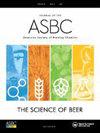Optimization of Mashing Parameters Used during the Conversion of Irish Wheat Grain to Spirit Alcohol
IF 1.8
4区 农林科学
Q4 BIOTECHNOLOGY & APPLIED MICROBIOLOGY
Journal of the American Society of Brewing Chemists
Pub Date : 2022-09-19
DOI:10.1080/03610470.2022.2116907
引用次数: 0
Abstract
Abstract The Irish distilling industry is rapidly expanding, diversifying its growth with an increased interest in using different grains in whiskey production. To effectively use Irish-grown wheat in distillation, the identification of cultivars that are suited to the Irish climate and provide high alcohol yields, via a quick screening test for grain alcohol yield that is consistent with Irish industry standards, is required. The current study used response surface methodology (RSM) to optimize mashing parameters, enzyme dosage rate (α-amylase and amyloglucosidase), time, temperature, and malt inclusion rate, using a hard wheat (Triticum aestivum cv. Costello). By optimizing all factors, a maximum alcohol yield (AY) of 471 LA/tonne dry weight basis was achieved, equating to previous research. The enzyme, α-amylase plays a critical part in the process, of converting starch to sugars, and 48 U/g α-amylase was used to reach maximum alcohol yield. Furthermore, an optimal protocol was evaluated on soft wheat cultivars, producing alcohol yields in the range of 483–496 LA/tonne, suggesting the applicability of this product for use across multiple varieties and grain endosperm types. In summary, an optimal alcohol yield methodology was created, with increased AY across four distinct varieties, demonstrating the possibility for Irish cultivated wheat to be used in Irish distilleries.爱尔兰小麦籽粒转化酒精过程中糖化参数的优化
摘要爱尔兰蒸馏行业正在迅速扩张,增长多样化,人们对在威士忌生产中使用不同谷物的兴趣越来越大。为了在蒸馏中有效利用爱尔兰种植的小麦,需要通过符合爱尔兰行业标准的谷物酒精产量快速筛选测试,鉴定出适合爱尔兰气候并提供高酒精产量的品种。本研究使用响应面法(RSM)优化糖化参数、酶用量(α-淀粉酶和淀粉葡萄糖苷酶)、时间、温度和麦芽包合率,使用硬小麦(Triticum aestivum cv.Costello)。通过优化所有因素,实现了471 LA/吨干重的最大酒精产量(AY),与之前的研究相当。α-淀粉酶在将淀粉转化为糖的过程中起着关键作用,48 使用U/gα-淀粉酶来达到最大的酒精产量。此外,对软小麦品种的最佳方案进行了评估,其酒精产量在483–496 LA/吨之间,表明该产品适用于多种品种和谷物胚乳类型。总之,创建了一种最佳酒精产量方法,在四个不同的品种中增加了AY,证明了爱尔兰种植小麦在爱尔兰酿酒厂使用的可能性。
本文章由计算机程序翻译,如有差异,请以英文原文为准。
求助全文
约1分钟内获得全文
求助全文
来源期刊

Journal of the American Society of Brewing Chemists
工程技术-生物工程与应用微生物
CiteScore
4.00
自引率
20.00%
发文量
41
审稿时长
3 months
期刊介绍:
The Journal of the American Society of Brewing Chemists publishes scientific papers, review articles, and technical reports pertaining to the chemistry, microbiology, and technology of brewing and distilling, as well as the analytical techniques used in the malting, brewing, and distilling industries.
 求助内容:
求助内容: 应助结果提醒方式:
应助结果提醒方式:


